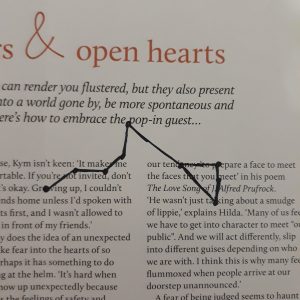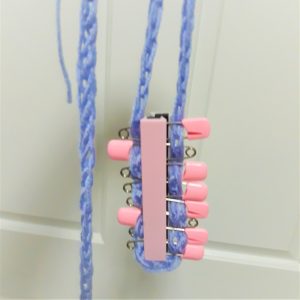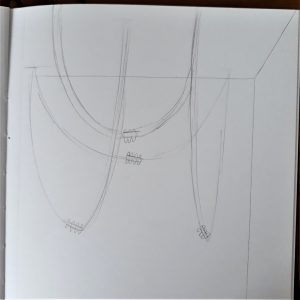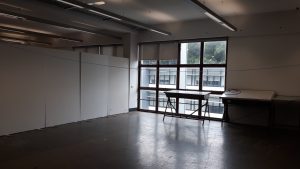“A god could do it. But tell me,how could a man follow him through his narrow lyre?”
Rainer Maria Rilke, “Sonnets to Orpheus”
It gave me the word “tendency.”
According to Google, tendency is defined as:
an inclination towards a particular characteristic or type of behaviour.
And according to my (old) copy of The Pocket Macquarie Dictionary (which cannot fit into your pocket at all, the blasted thing), tendency is:
natural movement in some direction or towards some point, end, or result.
Both dictionaries (if Google counts) state that tendency comes from the word “tend”, which has the double meaning of both “habit” and “care.” Tend itself comes from Latin “tendere”, or “to stretch.” The word tendency evokes other words, such as tender, as in “loving”, and tendon, as in the muscles that bind your joints together.
I decided to get a bunch of safety pins and sandwich them between two magnets. I had some loosely woven cord that I had made months ago, when I first attempted to weave. It was too loose and stretchy to be used for anything, but I kept it anyway. I “sewed” the cord between the gaps of the safety pins, until I had gotten all the way around the magnets on both sides. It was frustrating work. If I pulled the cord too tight, the pins would be ripped from the magnet and it would all fall apart. The pins would slip through the cord as I was not sewing them into another surface. But when I got all the way around, I held up the magnets and safety pins by the threads. They stayed put.
Now I’m not sure what my point is. I could be talking nonsense for all I know. But magnetism, like gravity, and entropy, and the heat death of the universe, is one of those things that we (currently) have no way to escape. To us humans, these things are so big and heavy and far away that we can’t imagine them, yet they’re affecting every molecule of our bodies everyday. There are closer things that do trap us, like our social bonds, and bloodlines, and what world leader is going to declare war on which country today. We tend to ourselves above all else. We stretch and thread and sew ourselves into rows of seats at the cinema and lines at the bank. And that’s only in public! In some ways, it is a necessity, but also distraction from the antipersonal physics of our cosmos. The cord may be strangling or comforting, it doesn’t matter, we can’t feel the crushing force of it, nor entirely comprehend how fragile our suspension in midair is. Our concern for others and self absorbed glory is what helps us survive but also frequently what tears us apart when we pull too tight.
I will leave the rest up to you.
15/01/20
I decided to upscale this.
As you can see from this draft, I want to weave a giantly long and loose cord, thread magnets and safety pins through them, and hang it from the ceiling.
The audience may take safety pins out of the sculpture. How concerned they are for how the magnets will stay together is up to them.
In this exhibition, all four forces of nature will be present. Gravity in the hanging of the thread, electromagnetism in the magnets, weak nuclear force in the degradation of carbon isotopes that occurs in all living things, and strong nuclear force that holds the nucleus of atoms together. Of course they are present everywhere, but:
“Wherever you put it, Foucault’s Pendulum swings from a motionless point while the earth rotates beneath it… That’s why the Pendulum disturbs me. It promises the infinite, but where to put the infinite is left to me… you’ve spent a lifetime hanging the Pendulum in many paces, and it’s never worked, but there, in the Conservatoire, it works…. Do you think there are special places in the universe? …I don’t know, maybe we’re always looking for the right place, maybe it’s within reach, but we don’t recognize it. Maybe, to recognize it, we have to believe in it.”
I do not intend to cover the entire ceiling with yarn. I’m not sure if I can even conquer a corner. I cannot braid that fast, especially as I’m considering using my hands rather than a lucet or French knitter, to add the work of my tendons and the strange tenderness of handiwork back into tendency.
In all likelihood, the lucet will be easier and most practical.
But that is okay. Freed from the expectation of finishing, it is the process that matters.
There are personal meanings to this artwork that can only be known by me. Such as that my affinity with textiles is inherited and symbolic of my familial and blood ties, or that the purple thread was chosen in response to the red thread of fate in East Asian mythology. None of it matters as much as what others get out of it.
16/01/20
I finished the thread.
On the guidance of the teacher, I decided not to entangle the safety pins and magnets inside them.
I wondered what I could do with one thread. I wanted to allow the audience to take pins out of it, so I could give something to them. I wanted to explore our tendency towards other human beings, an instinct as great as the four forces of nature and as irresistible as gravity to mass.
So I decided to sling the string between two screens, and tension it so the lowest point of the string is equal to my height.
Gravity is present. The other forces of nature are present too, inside you. I am present, even if my body is not physically there. You can see how tall and what size my hands were and how strong or weak they were to braid the cord.
If you saw string slung between two screens, you’d walk towards it, because you know it couldn’t have gotten there by itself and that a human must’ve put it there. We are magnetised to each other, even if we cannot see each other.
I look forward to seeing how people will react to it on Friday. I will be silent about all of this, of course, until I see their reaction. They are coming to see the experiment, not to see me, though lines between experiment and participant and artwork and artist become increasingly blurred.




